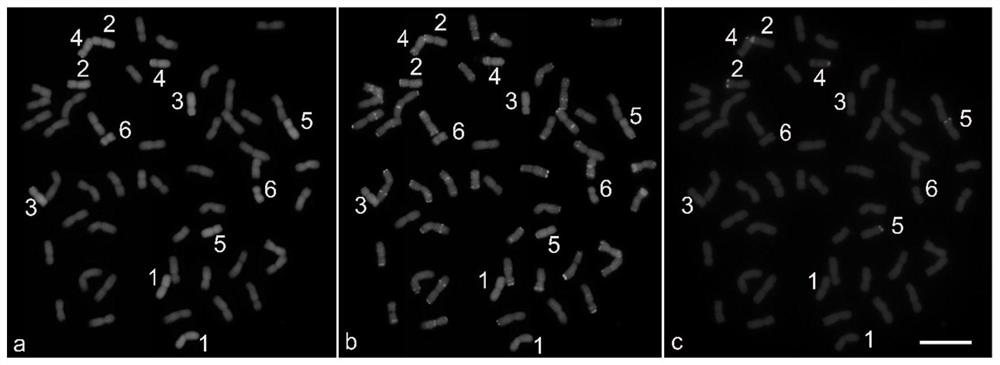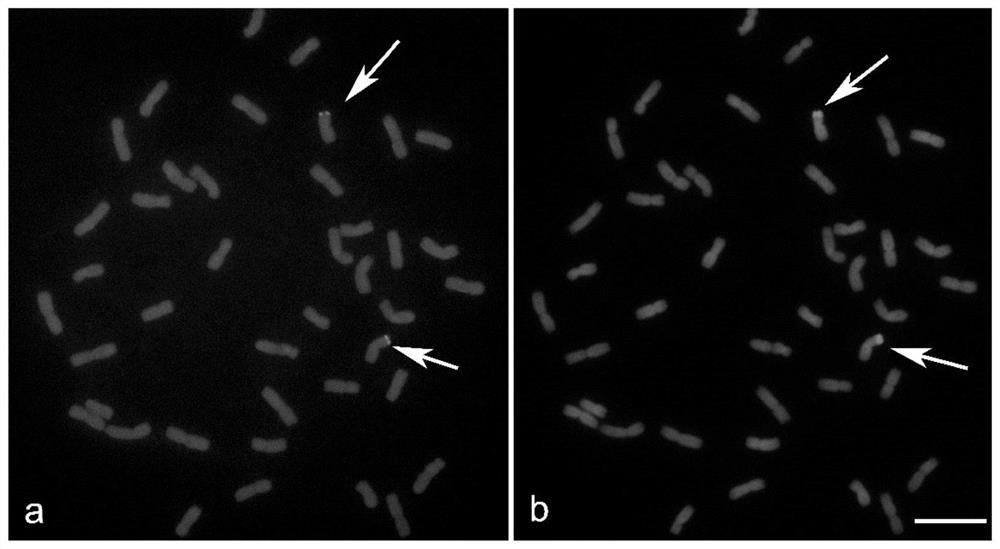Development and application of decaploid agropyron elongatum molecular marker and tandem repeat probe thereof
A technology of wheat grass and molecular marker, which is applied in the biological field and can solve problems such as Oligo probes that have not yet been seen
- Summary
- Abstract
- Description
- Claims
- Application Information
AI Technical Summary
Problems solved by technology
Method used
Image
Examples
Embodiment 1、 10
[0036] Example 1. Development of molecular markers and probes for decaploid Echinopsis elongatum
[0037] 1. Development of specific molecular markers for exogenous fragments of translocation line DT80
[0038] The inventors discovered a specific molecular marker of an exogenous fragment of DT80, which is denoted as pThp80.1, and its sequence (5'-3') is as follows:
[0039] GTACGGTCCGGAATTTCGTTTCCCGCCCAAAGTTTCGTCTCCCGCTTGAAATACAGTCTCGCGCCCGTTTCTCAA ATTTGGATCCCTCCATTTTGTATTTTTTTGGTATATTATTTTTTTGTGTCGGGGAGAGGCCGTGGCAATGGTGAACAATATAGCACACCCAAATTTGGCATGACGGCGAAATTTTCCCGCCAAAATCACGAAAAGTGACCACGTGTCCGTCGTCGTCGTCGTCGAAAATCGTGTCCGTGTCCGTCGAAATCGTGTCG
[0040] The molecular marker can be amplified by primer pair MWTT80-1 (composed of single-stranded DNA named MWTT80-1F and MWTT80-1R respectively), and the sequences (5'-3') of MWTT80-1F and MWTT80-1R are as follows:
[0041] MWTT80-1F: GTACGGTCCGGAATTTCGTT (sequence 2 in the sequence listing);
[0042] MWTT80-1R: GGGAGCGATTTGAGACACTC ...
Embodiment 2
[0070] Example 2. Distinguishing the 6 exogenous chromosomes of octoploid Tritium tritium 7430 by using the repetitive sequence probe pThp80.1
[0071] Xiaoyan 7430 (Zheng et al. 2014, 2015; Li et al. 2016) is an octoploid Tritititum obtained from the distant hybridization of Thipotinia elongatum and common wheat from the former Northwest Institute of Botany, Chinese Academy of Sciences. Molecular and cytological identification showed that it had 44 wheat chromosomes and 12 E. elongatum chromosomes. Disease resistance surveys found that it has good resistance to stem rust, stripe rust and powdery mildew. The inventor's research group used chromosome engineering to create the tritulinum isoaddition line Xiaoyan85 and the translocation line Xiaoyan447, which were derived from Xiaoyan 7430 and were highly resistant to Ug99 (Li et al.2016). Subsequently, Xiaoyan85 was irradiated with pollen, and the small fragment translocation lines Xiaoyan851, Xiaoyan852 and Xiaoyan853 were fur...
Embodiment 3
[0074] Example 3. Identification of Exogenous Chromosomal Segments in the Background of Wheat Using E. elongatum Specific Oligonucleotide Probe Oligo-pThp80.1-2
[0075] Translocation line DT80 mitotic metaphase cells were prepared, and Oligo-pThp80.1-2 in Step 3 of Example 1 was used as a probe for ND-FISH analysis. The experimental steps were the same as Step 3 of Example 1.
[0076] The results showed that there were punctate signals on the exogenous chromosome segment of the translocation line DT80, indicating that the Oligo-pThp80.1-2 probe could be used to trace the exogenous chromosome segment of the translocation line DT80 ( image 3 ).
PUM
 Login to View More
Login to View More Abstract
Description
Claims
Application Information
 Login to View More
Login to View More - R&D
- Intellectual Property
- Life Sciences
- Materials
- Tech Scout
- Unparalleled Data Quality
- Higher Quality Content
- 60% Fewer Hallucinations
Browse by: Latest US Patents, China's latest patents, Technical Efficacy Thesaurus, Application Domain, Technology Topic, Popular Technical Reports.
© 2025 PatSnap. All rights reserved.Legal|Privacy policy|Modern Slavery Act Transparency Statement|Sitemap|About US| Contact US: help@patsnap.com



